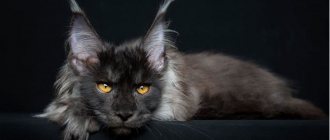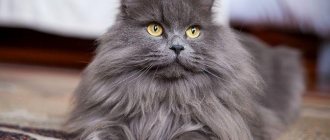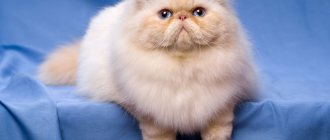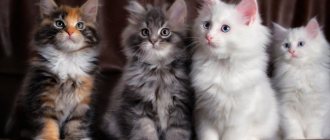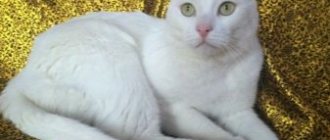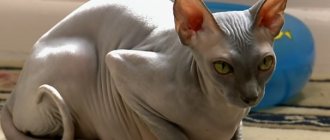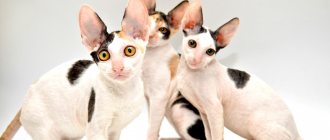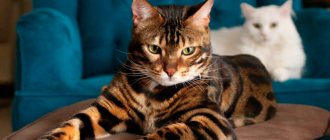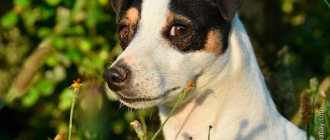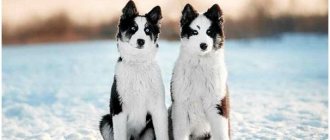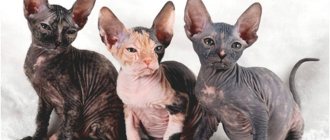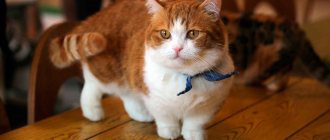There are several popular cat breeds that originate from Russia. For example, Russian blue cats are known all over the world, but the Ussuri cat rarely finds itself as a companion. Russian cat breeds differ both in appearance and in temperament, because they appeared in different parts of Russia from different ancestors.
10 Russian cat breeds
If you want to adopt a rare and unusual cat, it is better to first meet a representative of the breed. You will be able to understand how her character will fit with your lifestyle.
Kurilian Bobtail
The Kurilian Bobtail is a naturally occurring breed. These cats have lived for more than 200 years on Sakhalin Island and the Kamchatka Peninsula. They also live in the Kuril archipelago, connecting Russia and Japan. They look like predators, but in fact they are calm and affectionate. However, their instincts are well developed and they have high energy.
General characteristics
- HEIGHT : 23 – 30 cm
- WEIGHT : 4 – 8 kg
- APPEARANCE : soft, silky short to medium length coat; characteristic short tail; color red or gray with stripes
Key Features
“Native” cats were always taken as the basis for breeding; some individuals were crossed with wild species of felines, which was reflected in their appearance and character.
An important feature of Russian cat breeds is also their short pedigree (with the exception of the Siberian). It is quite difficult to find a cat with a history of more than four generations; for this reason, some cat breeds are not considered “canned”.
Very often, purebred kittens are sold without documents, as a result, there is a high risk of purchasing an outbred individual. When purchasing a purebred animal, you should always ask for documents and pedigree.
Characteristics, breed standard
The Russian Blue is registered in all known felinological associations.
A standard is a detailed description of the external appearance of a cat, sometimes its character, proposed by one or another felinological organization as a standard for breeders. The characteristics of any cat breed are almost completely the same across different associations. But with the Russian Blue everything is more complicated.
An expert from the American international felinological association TICA, Amanda Bryan, emphasizes that the Russian breed today has four main varieties, the standards of which are described in different systems:
- North American species - TICA and CFA;
- English subtype - GCCF;
- Scandinavian blue is very similar to American blue, but there are differences;
- European (or Russian) type - FIFe and WCF.
Although generally breeders emphasize two types - American and European.
Russian Blue breed standard for the European type of the WCF system:
- The head is of medium length, the skull is flat. The forehead and nose are straight, forming an obtuse angle at the level of the eyebrows.
- The whiskers are well developed and convex.
- The chin is strong, well developed, more powerful in cats.
- The ears are quite large, wide at the base and slightly pointed at the top, widely spaced, slightly tilted forward. The inner edge is weak, the ear appears transparent.
- The eyes are large, almond-shaped, and widely spaced. Any shade of green, with a bright emerald color being a plus. Kittens up to four months old are blue, changing as the individual grows older.
- Body. The size is medium, the type is muscular, quite strong, but at the same time gracefulness is maintained.
- Neck. Slender, quite long, visually appears shorter due to dense fur.
- The tail is long, proportional to the body, tapering to a rounded tip.
- Wool. Short, dense, double. The main hair and undercoat are the same length.
- The color is always blue with a silver tint (tipping on the tips of the fibers). Preference is given to the middle tone.
- The nose is gray-blue.
- The paws are of medium length, muscular, and quite graceful. The paw pads are pink with a purple tint.
Russian Blue breed standard, American type, TICA system:
- Head. Wedge-shaped with pronounced seven edges. The crown is narrow and straight. The nose is straight, the forehead is flat.
- Ears. Wider at the base, tapering and slightly rounded at the top. The length is almost equal to the width on the skull. Inside the ear there is a small edge and tassels. Set wide apart, covering the side surface of the head, akin to the oriental type.
- The eyes are large and almost round, slanted, oriental type. Always green, the brighter, the more valuable the individual.
- The body is light in build, narrow, long with thin bones. Muscular, but not heavy. Dense wool visually gives a squat appearance. Males are much larger than females.
- The neck is long and slender, the fur hides its length.
- The tail is long, wide at the base, tapering strongly towards the end.
- The coat is double and dense, but soft and silky to the touch.
- The color is bright blue, uniform throughout the body. Shines silver - tipping. Preference is given to a light tone.
- The nose is always charcoal gray.
- The paws are graceful, medium length, flesh-colored, pink pads.
For all felinological systems, the assessment of defects is the same:
- violation of the structure of the head;
- malocclusion;
- sunken or too prominent eyes;
- not straight back or deformed sternum;
- tail curls;
- poor health.
Grounds for disqualifying an animal:
- aggressive behavior or signs of tranquilizer use;
- signs of haircut, dyeing;
- cryptorchidism;
- polydactyly or olidactyly;
- visual impairment;
- umbilical hernia;
- white spots on the body.
These cats are medium in size and light in weight, about three kilograms in females and up to five kilograms in males. They are practically not prone to diseases and natural defects, and have a calm, flexible character.
Diseases
Since many breeds arose naturally, they are resistant to disease and even harsh climates. Most diseases can be prevented by preventive measures: vaccination, examination by a veterinarian. Antiparasitic drugs should be given at least once a year, even if the pet lives in the house. After walks in the warm season, it is necessary to inspect to ensure there are no ticks.
There may also be external parasites: fleas, lice eaters, ear mites. Special collars and drops help. Hypothermia should not be allowed, even if cats are cold-resistant. This can cause kidney inflammation.
Don Sphynx
The first kitten of the Don Sphynx with a bald back was taken from children on the street by a resident of Rostov-on-Don; the first offspring of the cat Varvara was also hairless, which gave rise to the development of a new breed. As a result of further breeding, another line of Sphynxes appeared, unrelated to the Canadian ones.
Representatives of this breed at first glance are very similar to their foreign counterparts, but a professional breeder or an experienced fancier will immediately notice the differences due to a different set of genes.
Kittens can be born completely bald, covered with short down or dense thick hair. The body structure is also lighter compared to Canadians, this breed is distinguished by a different eye shape and other little details, this is a real Russian breed that has earned worldwide recognition.
A kitten can be purchased for 9-30 thousand rubles.
Ussuri
Ussuri have a strong and proportional body with developed muscles. The tabby's color ranges from golden brown to fawn. At the ends of the ears there are tufts like those of a lynx.
The average life expectancy of Ussuri cats is 12-16 years. By character they resemble wild ones, they are independent and freedom-loving. They need a lot of space, which will be their hunting territory. This breed is not suitable for communicating with children, as they do not like it when someone invades their territory.
Siberian
The Russian cat breed originated in the Siberian forests as a result of crossing domestic breeds with wild steppe ones. Siberian cats are distinguished by their strong physique and thick, dense fur coat; due to these two factors, individuals look like real giants.
The weight of an adult animal can reach 12 kg, the size of cats is somewhat smaller, but they still remain quite strong, and at the same time harmoniously built cats.
The main feature of the breed is the coat; it is long, the undercoat is short, dense and thick, perfectly protecting the individual from the cold. The obligatory attributes of the breed are thick pants and a collar, hair between the toes, tufts on the ears; Siberian cats are distinguished by self-sufficiency, intelligence, strong and bright character.
A Siberian kitten can be bought for 10 thousand rubles.
Development of felinology in Russia
The most popular breeds of Russian cats are:
- Siberian;
- Neva Masquerade;
- Kurilian and Karelian bobtail;
- Ural rex;
- Russian blue and others.
Cat breeding began more than three centuries ago. But felinology reached its real flourishing only at the end of the 20th century. At this time, active work began to create new breeds or improve the qualities of existing ones. Specialists had the opportunity to exchange experiences with colleagues from other countries. Cats bred by Russian breeders are not inferior to foreign ones either in external qualities or in character.
Maintenance, care, feeding and health
This is one of the cleanest cats in the world. The “Blue Archangel” can lick itself for hours. Perhaps this is why this breed is known as odorless.
Such an increased interest in its fur coat results in a large amount of hair being absorbed by the pet. You should give your cat a special herb or paste purchased at a pet store to remove hairballs.
It has long been noticed that despite the undercoat having the same length as the main hair, even when shedding, there is practically no hair in the house.
Therefore, there are no difficulties in caring for the coat. Comb once every two weeks, more often during the period of coat change. You should not bathe - the undercoat has its own protective fatty lubricant. A healthy animal's fur always looks well-groomed and shiny. Matted hair hanging in icicles is one of the first unfavorable signs of an impending illness.
If, however, there is an urgent need to bathe the animal, the entire process must be carried out quickly and carefully. The pet does not like water procedures, rather tolerates them.
This ultra-clean animal will never go to the toilet in a dirty litter tray. If you are away from home for a long time during the day, it is better to put several of them in the apartment. It is also worth washing food bowls in a timely manner; Russians are not picky when it comes to food, but may refuse to eat from dirty dishes.
Today, this natural hunter does not need to obtain food on his own. Ready-made, high-quality premium or super-premium dry food will help make your pet’s diet complete and properly balanced.
If you want to pamper your pet, it is better to give him a piece of raw poultry meat, well frozen and washed in running water.
Arkhangelsk cats living in their own house or country house will happily hunt rodents. It is important to ensure that pest control is not carried out in the area at this time.
Like all cats of natural origin, the silver Russian has excellent health. No congenital defects or anomalies characteristic of this breed have been identified. Especially now that Arkhangelsk cats have returned to their natural genotype. The lifespan of these pets is fifteen to twenty years.
Deworming and treatment against external parasites should be carried out in a timely manner, at least once every three months. Vaccinate against rabies and viral infections annually. At the dacha, the cat must wear a flea collar.
For timely detection and treatment of systemic diseases, you should visit a veterinarian for preventive purposes, for example, before annual vaccination.
Altai blue-eyed
Blue-eyed cats are not very common, but they do occur; they all belong to the Oriental group. In other cases, blue eyes are considered a random genetic mutation, but in the Altai region a whole group of cats with this eye color was discovered, this trait is consistently passed on from generation to generation.
The main feature of the breed is considered to be blue eyes, otherwise the cat can look like a strong, healthy short-haired cat. It is worth noting that almost simultaneously in the United States, breeding of blue-eyed mutant individuals began; breeders gave them the name “Ojos Azules.”
The average cost of the Altai blue-eye is 50-60 thousand rubles.
Peterbald
A young breed bred in St. Petersburg in the 90s of the last century. Peterbald received CFF recognition in 1997.
- Appearance. The body is elongated, flexible, muscles are well developed. Narrow muzzle, large ears, wide-set eyes. They can be completely hairless or have very short fur on the head and paws.
- Character. Playful, sociable cats. They are curious and follow their owner everywhere. They don't like to be alone.
- Attitude towards children: friendly, willingly support joint games.
- Immunity. There is a high risk of colds.
- Typical diseases: rhinotracheitis, pneumonia.
Neva Masquerade
The Neva Masquerade is considered a descendant of the Siberian cat; the name appeared due to the unusual color of its face, as if it were wearing a carnival mask.
Another advantage of the breed is its non-standard color-point coat with bright eyes. Neva cats are very affectionate and sensitive, taking their place among favorite pets.
The cost starts from 2 thousand rubles. for a kitten without a pedigree and ends at 25 thousand rubles.
Ural rex
The origins of the Ural Rex breed date back to the pre-war era, but their numbers declined significantly after World War II. The breed gained fame only in the 80s. The official founder of the breed is considered to be the cat Vasily, born in 1988. As a social cat, this breed enjoys being around people and loves children. They are quiet and even-tempered by nature, and this breed is also quite tough and fearless. The breed was officially confirmed only in 2006.
Russian blue cat
This breed is considered one of the most famous and beloved in the world. Its main value lies in the absence of participation of breeders in its breeding; humans only supported the population. According to legend, several centuries ago, Russian English sailors stopping at the port of Arkhangelsk took cats with a unique gray-blue tint of fur on board as a souvenir.
The coat is short, thick, the shade is always the same - gray-blue, slightly shimmering, the character is soft and calm, the kittens are affectionate, playful, sometimes cats can show willfulness and stubbornness.
Prices vary between 8-35 thousand rubles.
How to choose
Several recommendations can help you make your choice:
- Decide on the breed: what appearance, character, behavior is attractive.
- Take into account the conditions of detention, the tendency to allergies.
- Select the gender of the kitten: boy or girl.
- Choose where to get a kitten: from a breeder, a nursery or a shelter.
A purebred animal must have pedigree documents, metrics, and a passport from a veterinarian. It is necessary to draw up a purchase and sale agreement.
It is better not to rush to take a kitten at a young age from its mother cat. An underfed pet will have weak immunity and reduced resistance to disease. At the age of 1 month it is just beginning to form. The kitten learns the necessary skills from its mother and learns to be independent. The optimal age when you need to pick up a kitten is from 3 months.
You need to evaluate your pet's health. The kitten must be inquisitive, active, and responsive to games. It is necessary to check the hearing, determining how it reacts to sounds, especially in white kittens. Other indicators:
- The eyes are not tearful.
- The nose is cold.
- The inside of the mouth is pink, the teeth are in place.
- The ears are clean and free of discharge.
Interesting! A healthy kitten has shiny fur without bald spots or wounds.
Egyptian Mau
The Egyptian Mau is a descendant of the cats of Ancient Egypt. Short coat, compact body and large almond-shaped eyes. Their distinctive feature is the “scarab” pattern on the face and “makeup”.
Makeup refers to a couple of lines running under the eyes. These cats attract attention due to their coloring. They can be smoky, silver or bronze in color.
Their spotted color was reminiscent of the ancient Egyptian relief, and the similarity with the sacred cats of Ancient Egypt and the original name make our imagination about these maus exciting. They were very revered in Ancient Egypt, they were compared to deities, for the murder of which they were sentenced to death.
For a long time, Egyptian cats were found only in their homeland, and only in the 50s were they first noticed in the USA. Even the Russian princess Trubetskoy was the owner of these cats, brought to her from Egypt itself.
Peterbald
The descendants of the Don Sphynxes are considered to be the St. Petersburg Sphynxes - Peterbalds; when they were bred, crossings were carried out with oriental cats. Wool may be completely absent or some types may be present, including brush, velor, flock.
Peterbalds are smart animals with a good character, they are active and intelligent, and they love their owners very much. Such cats will never conflict with people, they will find an approach to other pets, and will be patient with the obsessive attention of children.
The average price of a pet is 15 thousand rubles.
Character
There were legends about the character of the Arkhangelsk favorite among the people. This naturally occurring cat almost never made a sound. The cat in heat and the walking cat did not scream or mark territory in the house. The dangerous period could be determined rather by the animal’s excessive affection. The rest of the time, these royal animals remained calm and equanimous, sparingly demonstrating their love for their owner. But there is no phlegmaticity or arrogance in the temperament of these animals.
They are strongly attached to their owner. They always try to keep their “ward” in sight. Possessing excellent resistance to stress, they tolerate changes quite well - departures of family members, the appearance of other pets in the house.
If there are noisy children in the house, they will become their nannies and playmates. But the claws will never come out, even if the child accidentally caused pain. But with real offenders they can confidently stand up for themselves. There are known cases when, protecting offspring, the Arkhangelsk cat successfully dispersed a pack of dogs.
The middle-aged owner will enjoy sitting next to him on long evenings, listening carefully and assenting. Absolutely not vindictive. And, even if they were scolded, they will make a dissatisfied appearance and disappear from view for some time only to return with a royal bearing as if nothing had happened a few minutes later.
Since ancient times, they have been valued by Russian people as excellent hunters. Arkhangelsk had no equal in exterminating rats and mice in the yard and house. Today, the Russian Blue demonstrates its habits in any conditions - it will never lose interest in a butterfly, fly or bird, and will keep its eye on the object for hours until it captures the prey with one precise throw.
This cat is very smart, easy to educate and even train. The necessary skills should be instilled from early childhood. Then in a city apartment there will be no problems with the pet’s scratching post and toilet.
